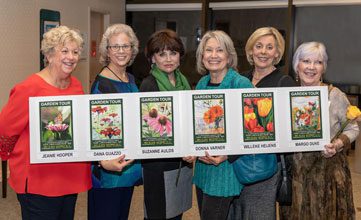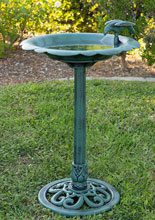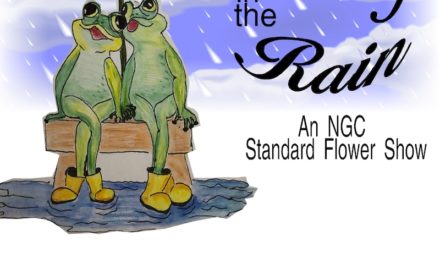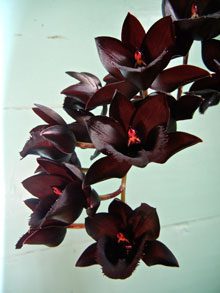 I have considered my duty solemnly, weighed all the pros and cons, evaluated the terrible ramifications. I must insist with all my strength that you do NOT start growing orchids.
I have considered my duty solemnly, weighed all the pros and cons, evaluated the terrible ramifications. I must insist with all my strength that you do NOT start growing orchids.
All it takes is one – just one little showy, flowering plant in a nondescript pot – and you have set yourself on a path toward doom. I know this sounds extreme, but you must trust me on this. I am writing this as one who speaks from personal experience, although one who still retains enough sense to know I must warn others of the folly of following this path. Soon, I know, I will be so overcome by the seductive vapors that I will be unable to muster even a mild warning to unsuspecting novices, and I will inexorably tumble down that rabbit hole and become – horrors! – a collector!
Everyone knows someone who has a few orchids on a windowsill; typically, that person is viewed with a strange mixture of awe and bewilderment, since everyone who doesn’t grow orchids assumes they are terribly delicate, incredibly difficult, and impossible to grow without investing a fortune in plants and the accoutrements their care must demand. Those who do grow orchids know well how silly those assumptions are, but some of us perhaps tend to encourage such illusions, since it elevates a mystique about our passion for orchids and our own exotic expertise.
(I may have to reconsider that observation about not investing a fortune to grow orchids. Obsessions, addictions, compulsions – they all render irrelevant a good-sense approach to a subject. It is often thus for orchid enthusiasts: more than one or two have found themselves searching for the most exotic, the most rare, the most new, and such pursuits can be surprisingly pricey. Similarly, if the subject of this orchidaceous passion should be of a type requiring peculiar growing conditions – say, arctic temperatures in winter and desert dry heat the rest of the year – well, then, providing such conditions can involve some expensive construction.)
What has brought on this last-ditch effort to protect you all from the evils of this demon weed, I must admit, is the endorphin overload I have recently experienced at the addition of two astonishing new orchids to my tiny collection.
For some twenty years I worked alongside some of the most completely wonderful people I’ve ever met, a long and fulfilling tenure at Chris Stanley’s Bay Street Trading Company Bookstore on Bay Street. The store’s been gone now for years, but the relationships among the staff remain so rich and vital that we gather every month or two for a long and gossipy meal and to acknowledge the birthdays of whoever among us has reached another of those milestones. I was the beneficiary of a recent “Bookies” gathering.
Ignoring a no-gifts policy, the gang presented me with two grand orchids from the collection 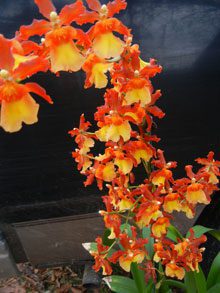 of a fine grower in Bluffton, May River Orchids’ Madeline Nelson. Madeline was there, too, to instruct me in caring for my new treasures. The answers to our questions were so simple and straightforward, it was hard to imagine we were talking about keeping orchids! Watering? Once a week or so – just check the medium they’re growing in for dryness; water them if it is dry. If the thick stems begin to show wrinkles, the orchids need water. Light? Keep these orchids out of direct bright sunlight – it will surely scorch the leaves. Instead, a brightly lit window facing east is perfect.
of a fine grower in Bluffton, May River Orchids’ Madeline Nelson. Madeline was there, too, to instruct me in caring for my new treasures. The answers to our questions were so simple and straightforward, it was hard to imagine we were talking about keeping orchids! Watering? Once a week or so – just check the medium they’re growing in for dryness; water them if it is dry. If the thick stems begin to show wrinkles, the orchids need water. Light? Keep these orchids out of direct bright sunlight – it will surely scorch the leaves. Instead, a brightly lit window facing east is perfect.
To be sure, other types of orchids often have other requirements or different care, but a well-informed successful grower can offer all kinds of tips for choosing and caring for the plants.
As I say, there were two new orchids in this wonderful birthday gift. One, a golden orange, red, and yellow Colemanara hybrid displayed a magnificent bloom spike with dozens of small, brilliant flowers covering the whole thing. The other was a very unusual Catasetum hybrid, whose leafless stems had sent up a pair of bloom spikes covered in richly textured flowers of a purple so dark it is almost black. Both are still breathtaking.
These two gifts join the few other orchids I have acquired accidentally or impulsively over the years. There is the huge Phaius tankervilleae, called the Nun’s orchid, which has now begun sending up its bloom spikes. Last year, it produced a magnificent spike about three and a half feet tall, topped by multiple brownish-purple orchid flowers that lasted for weeks. This year, it has so far started seven bloom spikes, and I expect all seven to reach three to four feet in height and to be filled with multiple flowers in the classic orchid form.
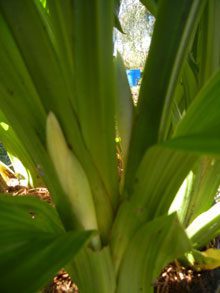 I particularly love the Nun’s orchid. It has survived two consecutive winters in which it froze to the ground, despite being protected. I was convinced it was dead, but in both instances, the orchid came back with vigor and beauty. A treasure, for certain.
I particularly love the Nun’s orchid. It has survived two consecutive winters in which it froze to the ground, despite being protected. I was convinced it was dead, but in both instances, the orchid came back with vigor and beauty. A treasure, for certain.
There’s another smaller orchid on the shelf, too, a gift from my colleague Anne. She had passed it on to me as it had sent up a second bloom spike for her last spring. I’ve noticed now that a third and fourth blooming branch have developed – it will still be a few weeks before any flowers open on those.
That’s it. Only a few orchids. I haven’t mentioned the numbers of orchids acquired over the years which did NOT thrive. Most displayed those gorgeous blooms for weeks of pleasure, then weakened due to my neglect or carelessness, and finally succumbed. The first few times, I was left heartbroken. After a while, though, I’ve come to accept that some thrive and some don’t. I try to learn from them both, lamenting the lost ones, but not mourning for long. They’re now so easy to find, so easy to care for, that replacements take their places on the sill and in my heart quite readily.
My recommendation, again, is to avoid at all costs falling prey to this addiction. If it’s too late for that, if your cravings have already gotten the best of you, then I suggest you build a relationship with someone who is a successful grower of orchids. Think of him or her as your sponsor, and when you feel overcome with the need for a new orchid, turn to this sponsor to guide you through the crisis. There are a number of amateurs in the Beaufort area with substantial experience and knowledge; their collections of orchids can be an inspiration; they can also reveal just how severe an affliction orchid addiction can be.
There are a few commercial growers of orchids as well. They can be as useful a resource as you can imagine, and can quickly become – like Madeline Nelson – a warm and supportive friend.
Don’t say I didn’t warn you!


